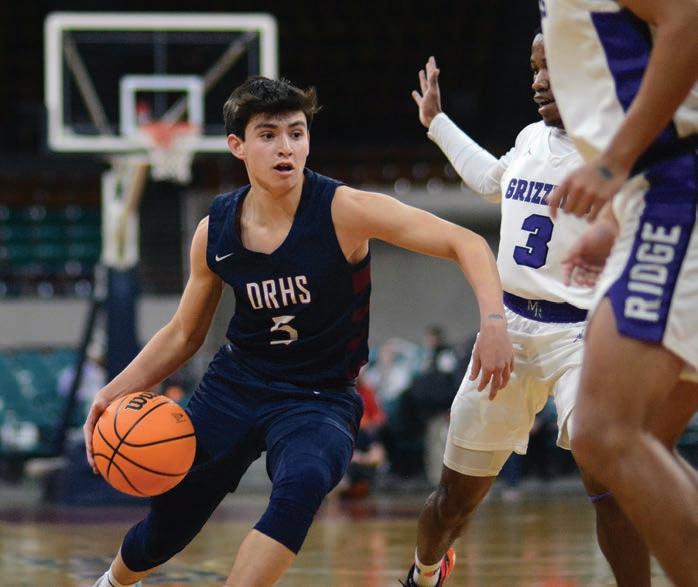
3 minute read
TRAINING
NASRO has state-specific branches, with Colorado’s being the Colorado Association of School Resource Officers, or CASRO. President of CASRO and Sgt. at the Douglas County Sheriff’s Office Mark Mithuen said SROs are essential for safety in schools.

“I can tell you there are SROs covering everything from medical calls to before it gets to the situation where there’s an incident, in terms of they’re able to evacuate kids if needed, if there’s a fire,” he explained. “If there are situations where there’s a carbon monoxide leak somewhere in the school, they can make sure the students are safe and are being evacuated.”
He continued that SROs are necessary to prevent and discover “people bringing weapons and these drugs laced with fentanyl into schools, to protect kids from dying and overdosing.”
The issue of there being only one training this year contributed to the bill being amended to focus on “continuous training.”
“Continuous training keeps it fresh, and more responsive to changing needs,” Kolker said.

“With that initial class, yeah everyone needs their training, and then you’re done. Five years later you only had that one training, how are you staying up to date?”
With that change in focus, the amendment removed the wording from generally mandating training to requiring an annual training meeting with SROs and school officials to discuss how best to respond to Safe2Tell reports, and training resources to better SROs’ “support of students and school staff.”
Safe2Tell is a youth-focused state program meant to allow students, parents, school staff and community members to anonymously report safety concerns to law enforcement, with SROs being a major part of that.
Kolker hopes annual and consistent training will also help officers be more knowledgeable about responding to these reports. He explained that a parent had told him their kids were afraid to call Safe2Tell from fear of “an officer showing up at their door in the middle of the night.”
He highlighted that officers responding to those reports don’t know how urgent it is, “so they are going to show up at 11:30, and they’re going to show up in a squad car, and they’re going to show up with all their gear on. And that can be a little intimidating.”
In January this year, the latest Safe2Tell monthly report, the top category of reports to Safe2Tell was suicide threats.
In terms of mandating the training, both Pierson and Mithuen agree that more training is always helpful, but do not agree with it being mandated. They also both don’t agree on it being required be- fore starting an assignment, though the caveat in the current bill does resolve that.
The concern is of safety if a lack of training prevents an officer from filling an SRO gap at a school.
“I think it is important they get the training up front, but I think we all understand in the District — as the only District that has had three school shootings — if there’s an officer to fill a void where we don’t have an SRO, and they don’t have the training yet, we’d be glad to onboard them prior to getting that training as opposed to not having an SRO onboard,” Pierson said.
Mithuen believes more that a wise choice of officer for an SRO — works well with children, interested in the job — is just as important, and training is more supplementary.
The main issue brought up is that required annual training would be difficult for more rural police forces who would have to travel more often, an issue Kolker acknowledged and said is being worked on.
Without the caveat excusing an officer from being trained for the SRO position beforehand, Pierson believes it would “tie not just law enforcement hands, but tie ours up as well.”
“I think SROs can have a negative image depending on the experience in that particular district, so I think that is always the eyebrow raise when you bring up the initial SRO….,” Kolker said in response to whether there has been push back against the bill. “Again, the goal is to provide the right training and the right resources so that we have more positive experiences.”
Some advocacy groups in Denver, such as Movimiento Poder, believe that training is not the issue, but the presence of police in schools themselves.
Movimiento Poder points to Colorado Department of Education data showing that Black students are disproportionately referred to law enforcement at school in Denver compared to their population and to the number of white students referred to police.
“You never know if someone’s there, what it is or what is not going to happen. It’s proven that SROs are essential for safety in the schools,” Mithuen said when asked about opponents to SROs in schools, pointing again to weapons, drugs, and evacuations, along with more violent situations such as school shooters, as examples of safety SROs help with.
Various studies from the University of Maryland, Brown University, University of Connecticut and more have shown little support for SROs preventing school shootings, and often arrests increase significantly, replacing school disciplinary action, again, leaning toward minority students.
“We can either do nothing, and there’s still going to be the negative, or we can try and make them better,” Kolker said. “And I think any kind of training we can receive, the ultimate goal is to make ourselves better.”









